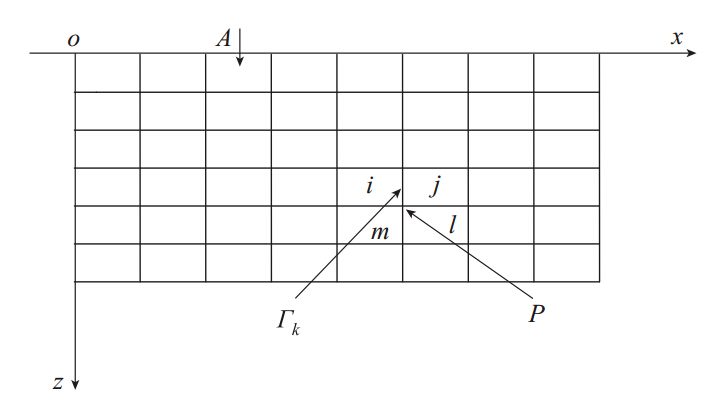Characteristics of the influence coefficient in the cases of deeply-buried configurations for geoelectrical resistivity observation
-
摘要: 讨论了地电阻率观测装置系统深埋条件下的影响系数特征. 采用这类装置的目的在于减小甚至消除来自表层产生的干扰,以提取深部可能的地震信息. 采用水平层状介质模型,应用边界积分方程法计算了不同装置埋深、不同装置参数下的影响系数及其与结构参数间的关系. 结果表明,不同地层影响系数的大小与电阻率结构、电极埋深、供电极距有密切且复杂的关系. 这表明为了有效地压制表层干扰并观测到底层变化,首先需要精细地探查测区电性结构,然后在此基础上,通过理论分析确认装置埋深及选定装置参数.Abstract: This paper deals with the characteristics of the influence coefficient in the cases of array deeply buried for geoelectrical resisitivity observations, which has been developed in recent years and aimed at decreasing or even eliminating the interference from the top layer and exacting the possible earthquake-related information from depth. The horizontal layered model has been taken into consideration in the study and the algorithm of the boundary integral equation has been adopted for calculating the influence coefficient, when the configuration of the array is located in the different depths under the ground surface. The calculations demonstrate the features that influence coefficient has been closely controlled by the structure parameters of the model, the depth of the buried array and the separation of the array. The results in this paper strongly suggested that one must pay great attention to the following steps in the studies of the deeply-buried array: the first, exploring finely the structure parameters of true resistivity in the observed media, and the second, confirming the depth for the array having been located and the configuration parameters corresponding to the model structure.
-
-
表 1 对称四极装置在地表时影响系数的计算结果(下伏低阻结构)
Table 1 The calculation results of influence coefficient with the observation array on the ground (The resistivity of the bed strata is the lowest)

表 2 利用本文方法得到的下伏低阻结构各层介质影响系数的计算结果
Table 2 The calculation results of influence coefficient with the observation array in different depth using the method proposed in this paper (The resistivity of the bed strata is the lowest)

表 3 对称四极装置在地表时影响系数的计算结果(下伏高阻结构)
Table 3 The calculation results of influence coefficient with the observation array on the ground (The resistivity of the bed strata is the highest)

表 4 利用本文方法得到的下伏高阻结构各层介质影响系数的计算结果
Table 4 The calculation results of influence coefficient with the observation array in different depth using the method proposed in this paper (The resistivity of the bed strata is the highest)

表 5 观测装置埋深350 m时不同供电极距下各层介质影响系数的计算结果(下伏低阻结构)
Table 5 The calculation results of influence coefficient with the observation array in depth of 350 m(The resistivity of the bed strata is the lowest)

表 6 观测装置埋深350 m时不同供电极距下各层介质影响系数的计算结果(下伏高阻结构)
Table 6 The calculation results of influence coefficient with the observation array in depth of 350 m(The resistivity of the bed strata is the highest)

-
杜学彬. 2010. 在地震预报中的两类视电阻率变化[J]. 中国科学: 地球科学, 40(10): 1321-1330. Du X B. 2010. Two kinds of changes in apparent resistivity in earthquake prediction[J]. Scientia Sinica Terrae, 40(10): 1321-1330 (in Chinese).
刘允秀, 吴国有, 王蕃树, 王邦本. 1985. 深埋电极地电阻率观测的实验结果[G]//地震预测: 地电方法论文集. 福州: 福建科学技术出版社: 206-216. Liu Y X, Wu G Y, Wang F S, Wang B B. 1985. Study on experimental results of buried electrode resistivity monitoring system[G]//Earthquake Prediction: Collection of Papers on Georesistivity Method. Fuzhou: Fujian Science & Technology Publishing House: 206-216 (in Chinese).
毛先进, 鲍光淑. 1998. 一种适于电阻率成像的正演新方法[J]. 地球物理学报, 41(增刊): 385-393. Mao X J, Bao G S. 1998. A new modeling method for resistivity tomography[J]. Acta Geophysica Sinica, 41(Suppl.): 385-393 (in Chinese).
孟庆武, 阎洪朋. 1991. 临沂台深井电阻率异常变化与地震的关系[J]. 西北地震学报, 13(4): 70-74. Meng Q W, Yan H P. 1991. Anomalous changes of resistivity in deep wells observed at Linyi station and its relation to earthquakes[J]. Northwestern Seismological Journal, 13(4): 70-74 (in Chinese).
聂永安, 姚兰予. 2009. 成层半空间深埋电极产生的电位分布[J]. 中国地震, 25(3): 246-255. Nie Y A, Yao L Y. 2009. Study on electrical potential by buried source electrode within horizontally layered half-space model[J]. Earthquake Research in China, 25(3): 246-255 (in Chinese).
聂永安, 巴振宁, 聂瑶. 2010. 深埋电极的地电阻率观测研究[J]. 地震学报, 32(1): 33-40. Nie Y A, Ba Z N, Nie Y. 2010. Study on buried electrode resistivity monitoring system[J]. Acta Seismologica Sinica, 32(1): 33-40 (in Chinese).
钱家栋, 赵和云, 张文孝. 1986. 水平层状介质视电阻率的高精度计算公式及其误差分析[J]. 西北地震学报, 8(2): 10-19. Qian J D, Zhao H Y, Zhang W X. 1986. Calculation formula of apparent resistivity of horizontal layered medium with high accurace and analysis of their error[J]. Northwestern Seismological Journal, 8(2): 10-19 (in Chinese).
苏鸾声, 王邦本, 夏良苗, 李验轩. 1982. 井下电极观测地电阻率排除地面干扰的实验[J]. 地震学报, 4(3): 274-276. Su L S, Wang B B, Xia L M, Li Y X. 1982. Elimination of surface disturbances in earth-resistivity measurement by lowering the electrodes in shallow wells[J]. Acta Seismologica Sinica, 4(3): 274-276 (in Chinese).
解滔, 杜学彬, 陈军营, 安张辉, 谭大诚, 范莹莹, 刘君. 2012. 井下地电阻率观测中地表电流干扰影响计算[J]. 地球物理学进展, 27(1): 112-121. Xie T, Du X B, Chen J Y, An Z H, Tan D C, Fan Y Y, Liu J. 2012. Calculation for the influence from the surface disturbance current in the deep-well geoelectrical resistivity observation[J]. Progress in Geophysics, 27(1): 112-121 (in Chinese).
张国民, 傅征祥, 桂夑泰等编著. 2001. 地震预报引论[M]. 北京: 科学出版社: 214-270. Zhang G M, Fu Z X, Gui X T, et al eds. 2001. Introduction to Earthquake Prediction[M]. Beijing: Science Press: 214-270 (in Chinese).
-
期刊类型引用(22)
1. 刘海洋,艾萨·伊斯马伊力,徐衍刚,韩时雨. 2020年伽师M_S6.4地震前柯坪台地电阻率数据变化分析. 内陆地震. 2024(03): 273-280 .  百度学术
百度学术
2. Yun WANG,Yaxin YANG,Heping SUN,Chengliang XIE,Qisheng ZHANG,Xiaoming CUI,Chang CHEN,Yongsheng HE,Qiangqiang MIAO,Chaomin MU,Lianghui GUO,Jiwen TENG. Observation and research of deep underground multi-physical fields—Huainan –848 m deep experiment. Science China(Earth Sciences). 2023(01): 54-70 .  必应学术
必应学术
3. 王兰炜,张宇,张兴国,胡哲. 地电阻率观测中地铁杂散电流特征. 地震学报. 2023(02): 285-301 .  本站查看
本站查看
4. 张宇,王兰炜,胡哲,张世中,张兴国,娄晓宇. 加权平均算法在地电阻率日均值计算中的应用. 地震. 2023(02): 25-37 .  百度学术
百度学术
5. 文雯,毛先进. 地电阻率小偶极装置观测的特性. 华北地震科学. 2022(03): 50-54 .  百度学术
百度学术
6. 赵斐,叶青,杨晓鹏,牛延平,张远富. 甘肃平凉地电比测台站建设及地电阻率数据分析. 中国地震. 2022(01): 142-152 .  百度学术
百度学术
7. 毛先进,段炜,杨玲英,文雯,钱家栋. 分层均匀结构地电阻率影响系数一个重要特性普适性的证明. 地震研究. 2021(01): 129-132 .  百度学术
百度学术
8. 黄明威,张琪,李梦莹,杨牧萍. 新城子井下地电阻率观测影响系数分析. 防灾减灾学报. 2020(01): 49-56 .  百度学术
百度学术
9. 赵斐,张远富. 平凉台井下地电阻率年变特征及相关性分析. 高原地震. 2020(01): 45-51 .  百度学术
百度学术
10. 肖武军,解滔,胡玉良. 冬奥会保障项目井下地电阻率观测专用电缆设计与测试. 中国地震. 2020(01): 146-152 .  百度学术
百度学术
11. 张秀萍,王曰风,张广莉,张珊珊,周亚. 河北阳原台地电阻率年变消除方法及映震效果. 地震科学进展. 2020(06): 22-27 .  百度学术
百度学术
12. 毛先进,文雯,杨玲英,段炜. 滇西地区几个测点的大地电磁视电阻率影响系数分析. 地震研究. 2020(04): 732-737 .  百度学术
百度学术
13. 文雯,毛先进,杨玲英,段炜. MT/CSELF视电阻率影响系数及各地层贡献的初步研究. 华南地震. 2020(04): 29-34 .  百度学术
百度学术
14. 解滔,于晨,卢军. 开展小极距井下地电阻率观测的可行性分析. 中国地震. 2019(01): 14-24 .  百度学术
百度学术
15. 肖武军,解滔,张尧. 晋冀蒙交界及附近地区小极距井下地电阻率观测装置设计. 中国地震. 2019(01): 134-143 .  百度学术
百度学术
16. 毛先进,段炜,庄儒新,杨玲英,赵晋民. 井下地电阻率观测中布极参数的确定方法. 地震研究. 2019(01): 96-101 .  百度学术
百度学术
17. 樊晓春,解滔,吴帆,袁慎杰. 井下地电阻率观测影响系数分析——以江宁地震台为例. 中国地震. 2019(02): 347-358 .  百度学术
百度学术
18. 赵斐,叶青,解滔,范晔,张远富. 平凉台井下地电阻率观测影响系数分析. 中国地震. 2018(01): 104-111 .  百度学术
百度学术
19. 刘君,梁子彬,陈军营. 平凉深井观测地电阻率影响系数特征分析. 甘肃科技. 2018(19): 60-64 .  百度学术
百度学术
20. 毛先进,杨玲英,赵晋民,段炜,庄儒新. 井下地电阻率观测的探测深度初步研究. 地震学报. 2017(02): 230-238 .  本站查看
本站查看
21. 杜学彬,孙君嵩,陈军营. 地震预测中的地电阻率数据处理方法. 地震学报. 2017(04): 531-548 .  本站查看
本站查看
22. 胡哲,蒋延林,张秀霞,赵卫红,杨恒勇,王福才,张骞. 地电观测深井电缆的研制. 中国地震. 2017(02): 338-344 .  百度学术
百度学术
其他类型引用(1)





 下载:
下载:
